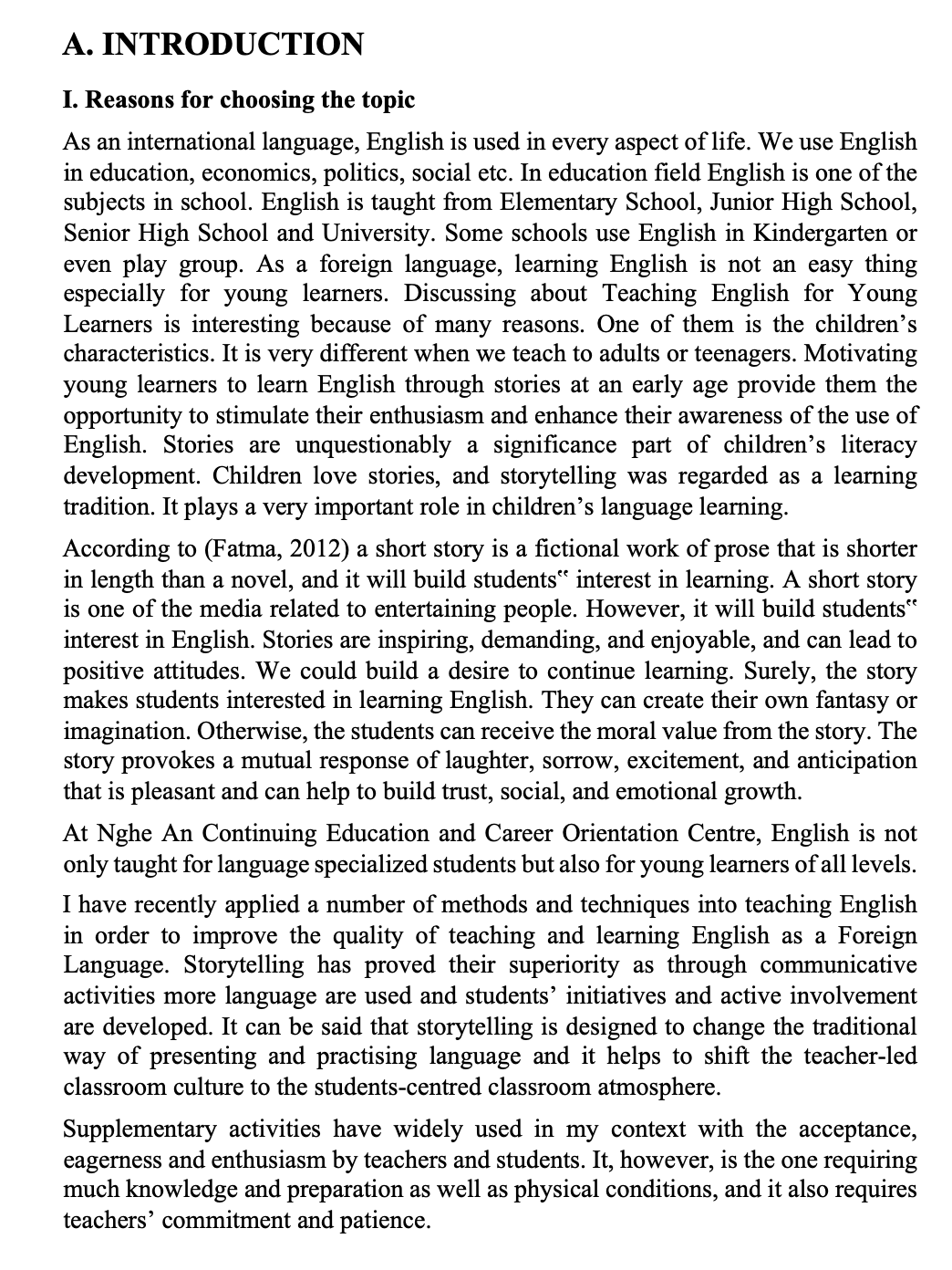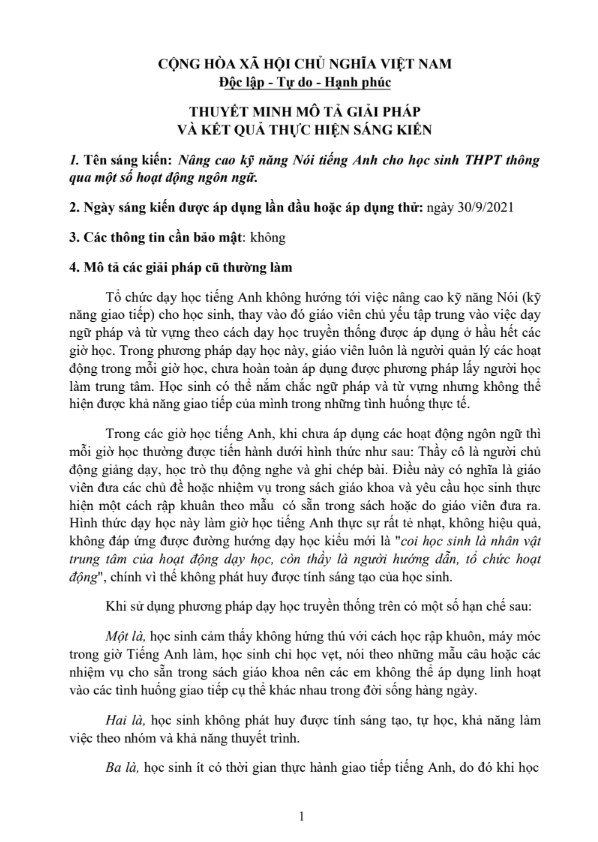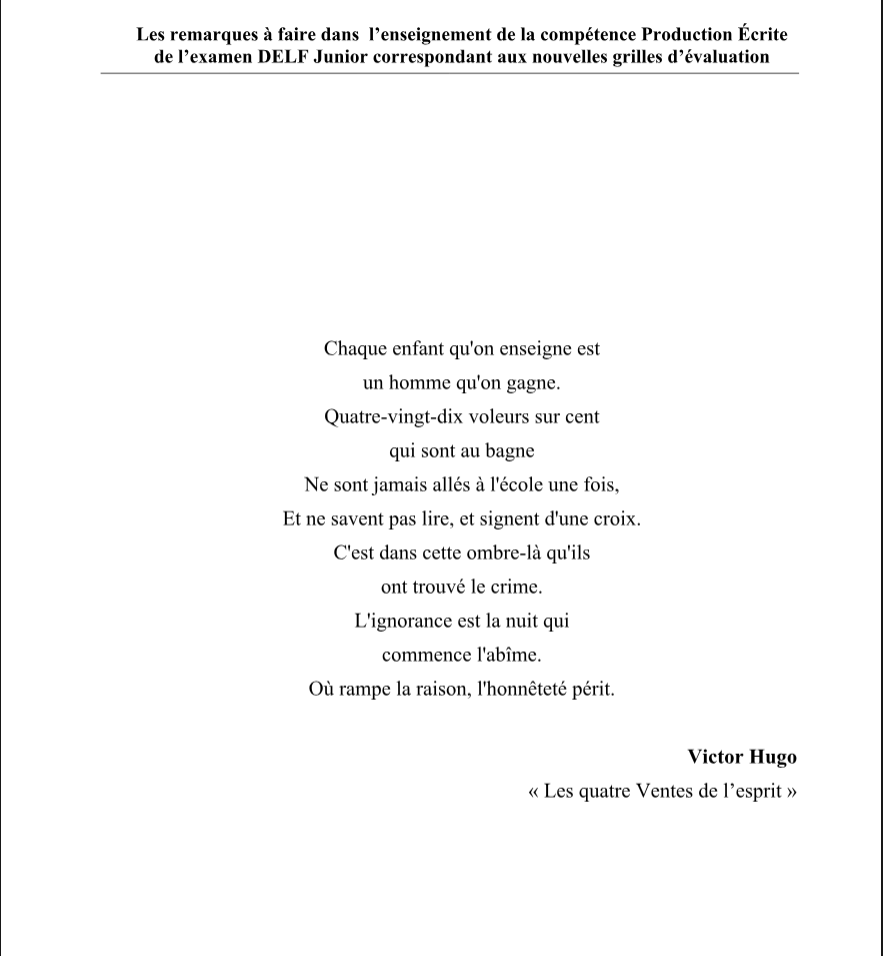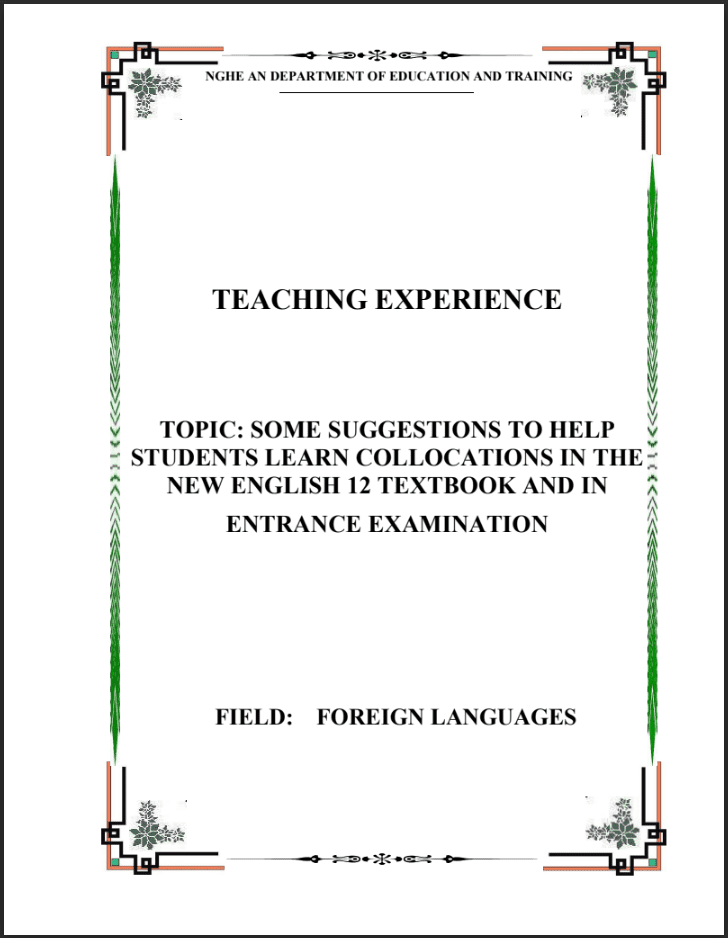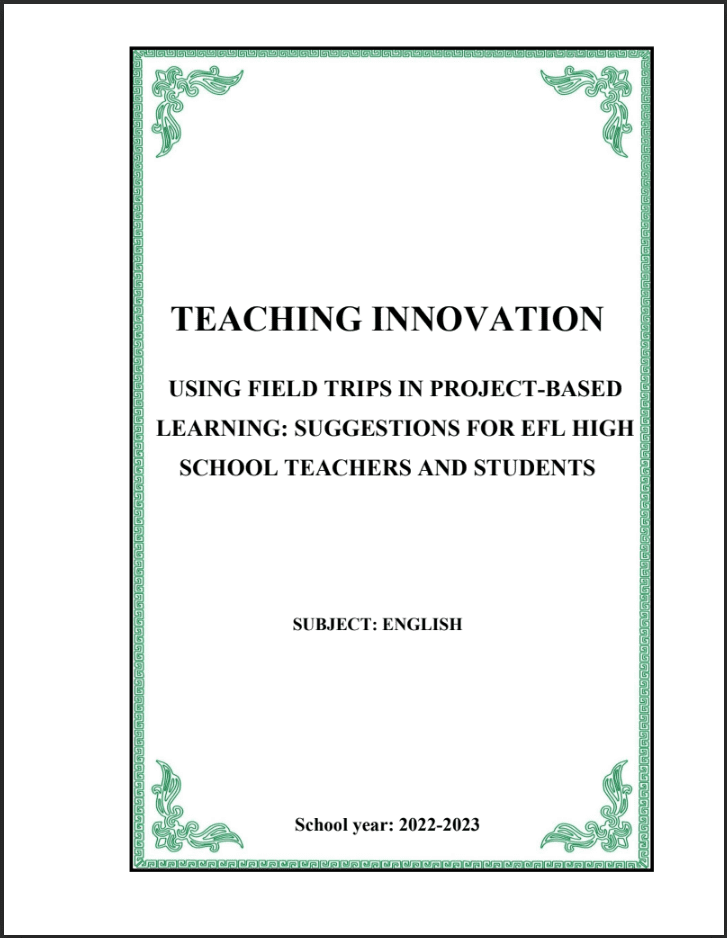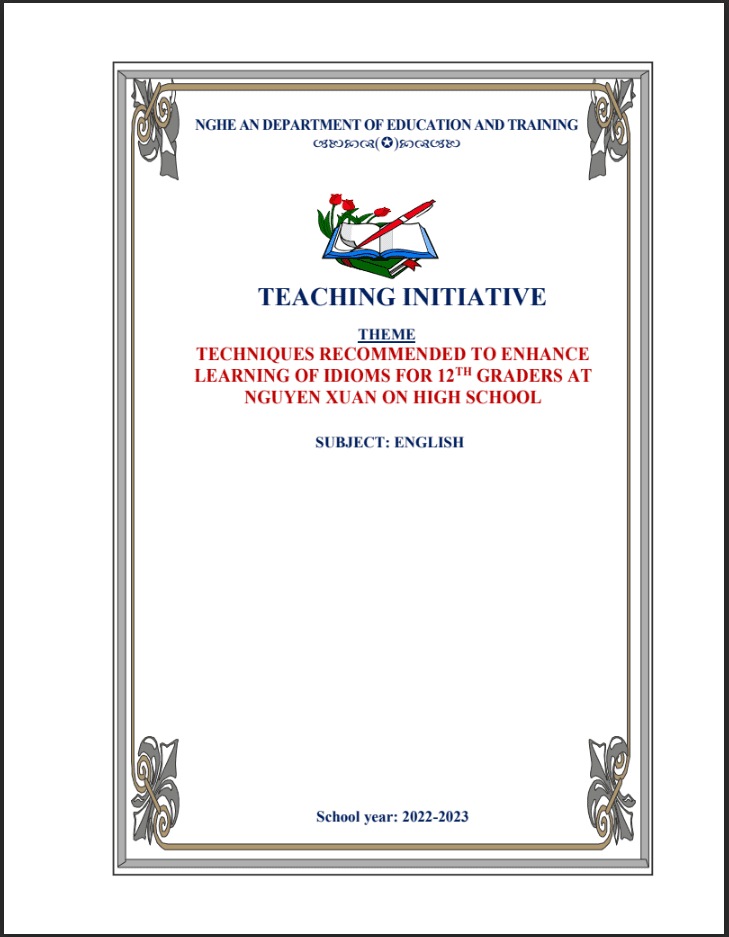Sáng kiến kinh nghiệm Teaching English through storytelling
- Mã tài liệu: MP0064 Copy
| Môn: | Tiếng anh |
| Lớp: | 10, 11, 12 |
| Bộ sách: | |
| Lượt xem: | 617 |
| Lượt tải: | 4 |
| Số trang: | 35 |
| Tác giả: | Đặng Thị Thu Hà |
| Trình độ chuyên môn: | Thạc sĩ giáo dục |
| Đơn vị công tác: | THPT Tương Dương 1 |
| Năm viết: | 2021-2022 |
| Số trang: | 35 |
| Tác giả: | Đặng Thị Thu Hà |
| Trình độ chuyên môn: | Thạc sĩ giáo dục |
| Đơn vị công tác: | THPT Tương Dương 1 |
| Năm viết: | 2021-2022 |
Sáng kiến kinh nghiệm “Sáng kiến kinh nghiệm Teaching English through storytelling” triển khai gồm các biện pháp nổi bật sau:
2.1. Memory check
2.2. Word search
2.3. Brainstorming .
2.4. Re-odering
2.5. Re-telling
2.6. Check-up:
2.7. Description:
2.8. Matching:.
Mô tả sản phẩm
A. INTRODUCTION
I. Reasons for choosing the topic
As an international language, English is used in every aspect of life. We use English in education, economics, politics, social etc. In education field English is one of the subjects in school. English is taught from Elementary School, Junior High School, Senior High School and University. Some schools use English in Kindergarten or even play group. As a foreign language, learning English is not an easy thing especially for young learners. Discussing about Teaching English for Young Learners is interesting because of many reasons. One of them is the children’s characteristics. It is very different when we teach to adults or teenagers. Motivating young learners to learn English through stories at an early age provide them the opportunity to stimulate their enthusiasm and enhance their awareness of the use of English. Stories are unquestionably a significance part of children’s literacy development. Children love stories, and storytelling was regarded as a learning tradition. It plays a very important role in children’s language learning.
According to (Fatma, 2012) a short story is a fictional work of prose that is shorter in length than a novel, and it will build students‟ interest in learning. A short story is one of the media related to entertaining people. However, it will build students‟ interest in English. Stories are inspiring, demanding, and enjoyable, and can lead to positive attitudes. We could build a desire to continue learning. Surely, the story makes students interested in learning English. They can create their own fantasy or imagination. Otherwise, the students can receive the moral value from the story. The story provokes a mutual response of laughter, sorrow, excitement, and anticipation that is pleasant and can help to build trust, social, and emotional growth.
At Nghe An Continuing Education and Career Orientation Centre, English is not only taught for language specialized students but also for young learners of all levels.
I have recently applied a number of methods and techniques into teaching English in order to improve the quality of teaching and learning English as a Foreign Language. Storytelling has proved their superiority as through communicative activities more language are used and students’ initiatives and active involvement are developed. It can be said that storytelling is designed to change the traditional way of presenting and practising language and it helps to shift the teacher-led classroom culture to the students-centred classroom atmosphere.
Supplementary activities have widely used in my context with the acceptance, eagerness and enthusiasm by teachers and students. It, however, is the one requiring much knowledge and preparation as well as physical conditions, and it also requires teachers’ commitment and patience.
1
I have been trying to put some of those into practice. I have been adapting and designing myself a repertoire of communicative activities which have been used and from which students have benefited.
I would like, in this paper, to introduce using storytelling to teach English with some supplementary activities to you all – teachers of English in a view of sharing experience and seeking for common thoughts to makes a change, however small it is, in teaching and learning English though it is hard work really. Storytelling has been used for teaching vocabulary, pattern and developing language skills. I shall not categorise them as some of them can be used for all about mentioned purposes. Some of activities I have adapted from other resources, and others I have designed myself.
To improve the students’ effectiveness of learning English and have a good result in teaching English for young learners at Nghe An continuing Education and Career Orientation Centre, I have followed a number of steps to be able to generate enthusiasm in teaching and learning. Once they have gained, know how to learn vocabulary and pattern through reading stories, they will find reading skill easier.
Above all, for teachers, the facilitators will help them be active, creative, feel responsible not only does he teach, moderate, but also inspire young learners.
In this paper, I would like to give some ideas about how to use storytelling skill in teaching English for young learners such as vocabulary and pattern… effectivelly to help our children feel easier and more confident during their study.
II. Research Question
Having gone through some relevant literatures on teaching English skills, the researcher formulate the following two research questions.
- Does teaching short story develop the third , the fourth and the fifth grade student‟s English skills at Nghe An continuing Education Centre? 2. Do pupils think of using short story develop their English skills?
III. The Aim of this Study
The aim of this study is to know the fifth grade students ‟development on English skills through teaching short story at Nghe An continuing Education and Career Orientation Centre.
IV. Scope of the study and significance of study
In this writing, I’d like to share my suggestions that I have gathered in my during preparing lessons, on using different kinds of short stories as inputs to help our young learners practise and improve English skills.
The significances of this study were expected to provide some advantages for English teaching and learning process. The significances of this study are:
- For young learners as the subjects of the study, it was expected that they would take the advantages of the study. They could learn how to improve their skills of speaking, reading, listening.
- For the teachers at Nghe An Continuing Education and Career Orientation Centre, it was expected that the teachers could improve their technique of teaching interestingly and effectively so that the pupils would enjoy the study.
B. CONTENT
- Literature Review
1. Definition of Storytelling
“Storytelling is the art of sharing aloud mythology and legend, fables, folk, and fairy tales, family stories and original tales in the oral tradition”. Moreover, Shorrocks (1995:60) states that “storytelling Technique is the act of using voice and body language to communicate a narrative directly from one person to another”. In addition, story is the full sequence of events in a work of fiction as we imagine them to have taken place, in the order in which they would have occurred in life.
Furthermore, Leung (2004:24) argues that “storytelling is about organizing information into a meaningful context, conveying emotions and building community”. In conclusion, stories can be used in ESL learning to teach the language, to entertain, and to open a window on cultures. When using stories in the classroom, teachers shall consider the importance of the story, the characteristics of a good story, and the types of stories which are most suitable for the students being taught. Teaching English through stories needs good technique. According to Wright
(1995:10), “the teacher should consider technique before telling the story, the ways of the beginning, the manner, the voice, the language, the accent and the body”. Teachers can use stories to teach language and to introduce other subjects such as culture and society. Stories from around the world are excellent to use in the classroom, but teachers also need to use stories from the students’ own culture and heritage.
2. The Importance of using storytelling in teaching
Using stories for educational purposes is an effective teaching strategy especially for teaching young learners. Most young learners enjoy listening to the stories. Stories have power which can bring the young learners into a world of imagination and draw a colorful picture with many interesting characters in the story. Storytelling is one of the most useful techniques to attract young learners in learning process effectively. Telling stories have a good chance for young learners to discover experience of real life and the language learning experience together. Storytelling is a kind of teaching method which can help the young learners to knowledge, literacy, imagination, creation and critical thinking. Therefore, storytelling would be very useful to teach foreign language for young learners. It promotes expressive language development in oral and written form and present new vocabulary and complex language in the powerful form that inspires children to emulate the model they have experienced. On the other words, storytelling is an important tool for language teaching and learning. Story telling for young learners is vitally important to create constructive and creative comprehension. Storytelling motivates children to be active participant in the construction of meaning of the story. In this activity, children involved while listening to the story so they can
TÀI LIỆU LIÊN QUAN
- 7
- 105
- 1
- [product_views]
- 5
- 173
- 2
- [product_views]
- 4
- 165
- 3
- [product_views]
- 4
- 129
- 4
- [product_views]
100.000 ₫
- 6
- 434
- 5
- [product_views]
100.000 ₫
- 2
- 507
- 6
- [product_views]
100.000 ₫
- 9
- 546
- 7
- [product_views]
100.000 ₫
- 4
- 409
- 8
- [product_views]
100.000 ₫
- 2
- 595
- 9
- [product_views]
100.000 ₫
- 0
- 538
- 10
- [product_views]

